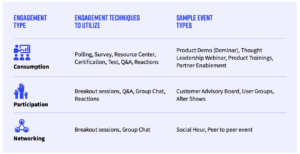Trend Report: Putting Engagement Type into Action
Once you have the type of engagement you’re trying to drive for audiences, it becomes easier to align the event type. Based on this, there is a sample matrix of event types aligned to engagement types. Most organizations had a taxonomy of event types for physical experiences. With the increase in hybrid events and the proliferation of digital event types and the need to unify physical and digital event types, there is a need for an approach that takes the engagement approaches and techniques and turns them into experiences.

Sessions with Multiple Engagement Types
There are also scenarios where a single experience can incorporate multiple engagement types. For example, you may want to begin with an event where audiences are just being educated on information (Consumption) but then you want to enter a phase two where the engagement type is participation through a breakout session. Another option would be an experience where audiences are participating in the content but then move to a more informal portion of the event where they can network or meet with each other one on one to further the conversations or points that were brought up earlier in the sessions.
Engagement Types & Larger Experiences
Additionally, for half-day, full day and multi-day events, there will be sessions with different engagement types. It is critical to have this mapped as part of the overall agenda to ensure each session is being constructed with engagement in mind. Additionally, it is critical to choose the order of these sessions with an event wisely, making sure not to overload any one day or part of the day towards a single type of session experience. Using this approach will also help to align expectations and ensure appropriate metrics for success are set up at the session level.
An important element of this is acknowledged that a larger, multi-day event or even a smaller multi-session event on one day is audience-led programming. Whereby audience members get to set their own agenda. Many events do Tracks, or a curated set of programming that aligns to a theme or persona, events and marketing teams should treat these as recommendations rather than prescriptions for audiences.
Putting this into Practice
Aside from taking this information and planning for future events. It is also helpful to use this structure to better think about past events as well. For example, did you have a great event but felt like participation and engagement was low? Perhaps you had expectations for a Participation event but delivered it through a Consumption experience. Additionally, clearly stating what engagement type you are using for future events will make sure you have an events portfolio that is balanced in the engagement that it is trying to drive. Especially in companies where events are being used to reach multiple audiences, you must use this as an audit mechanism. For example, you wouldn’t want to create Networking-only engagement for audiences that are looking to be educated and may be doing research for an upcoming purchase.
Marketers and events teams have a rapid landscape of event types to explore. While the Center for Marketing Transformation has outlined sample event types above, there is a massive amount of innovation that can occur within the construct of engagement-led experiences. Furthermore, decoupling the engagement you’re looking to drive from the delivery mechanism (in-person, digital or hybrid) allows marketers to put engagement at the center, rather than a marketing-led construct of delivery mechanism. This will also empower teams to better evaluate the success of an event by using metrics that align to engagement type, rather than simple vanity metrics.